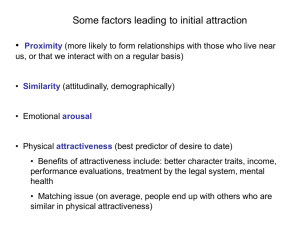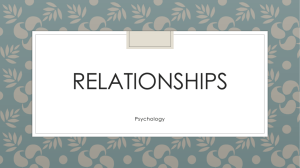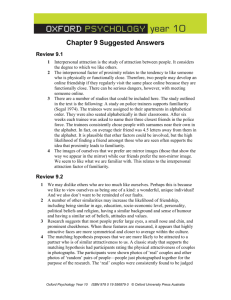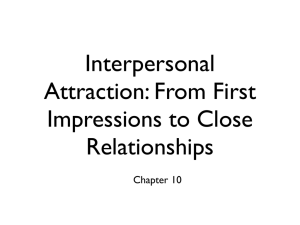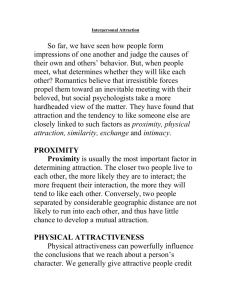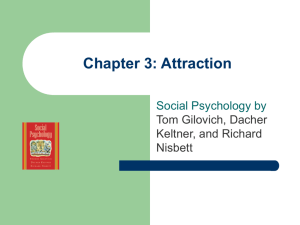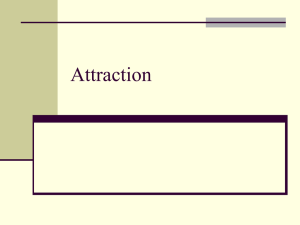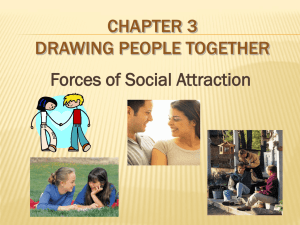File - Psychology LA
advertisement
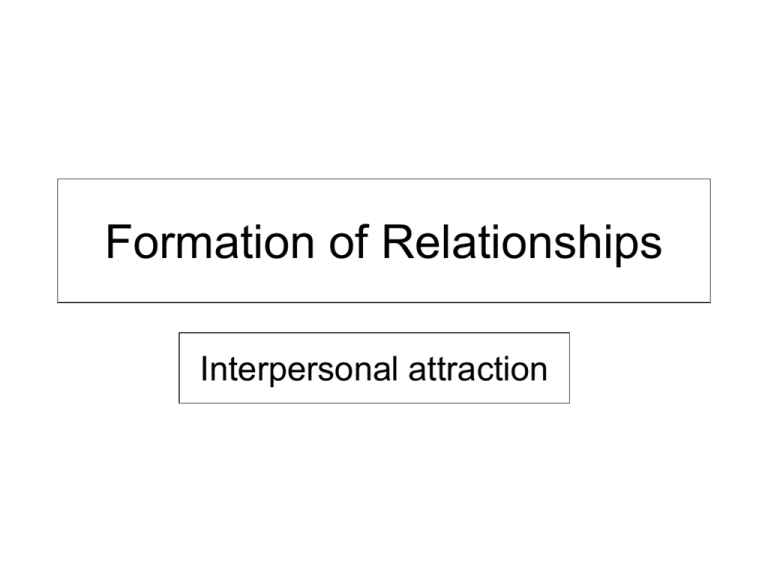
Formation of Relationships Interpersonal attraction Starter With a partner list as many reasons as possible as to why two people start a romantic relationship Extension – compare these with reasons for starting any relationship (friendship for example) Learning Outcomes • Identify reasons what/why relationship start. • Outline key features of the reward/need and similarity theory of formation of relationships • Describe a piece of research which supports each theory • Identify strengths and weaknesses of these theories of formation of relationships Big Picture • Work in pairs – card sort • Make notes on the two theories including evaluation points • Discuss in pairs • Create a summary of a couple using both the reward/need theory and the similarity theory • Write down homework Task 1 • In pairs look at the case studies and think about the similarities/reasons for these relationships forming. • On a blank A4 piece of paper draw a full body sketch (not naked) of your ideal romantic partner. To the sides of the drawing list the characteristics that you think this person should possess. • Reasons why relationship start • Contact/proximity • Physical appearance • Similar attitudes and social background Contact/proximity • Bossard (1932) – over 50% of marriage applicants in Philadelphia lived within walking distance of each other. • Festinger et al (1950) – Friendship formed by students in halls of residence far more likely if living on the same floor. Physical Appearance • Hatfield et al. (1966) assessed the personalities and aptitude of 752 first year male and female students. They were then randomly paired and at a special occasion each couple danced and chatted for several hours. Afterwards they were interviewed about their dates. • Did personality characteristics influence attraction? • Did aptitude influence attraction? • Did self esteem / lack of anxiety influence attraction? • No. For both men and women the only thing at mattered was the physical attractiveness of their partner. • Researchers have found that men put more value than women on physical attractiveness, but women too, respond to a man’s looks. Theories of physical attraction 1. The matching phenomenon (Murstein 1972) • Not everyone can end up being paired with a stunning partner. • So we tend to pair off with people who are of a similar level of attractiveness. • Similarity in physical attractiveness is also conducive to good relationships. • In cases where there is an apparent imbalance in a couple’s attractiveness, the less attractive person usually has compensating qualities, e.g., money. Who would you rather go on a date with? John is 35 years old, works as a warehouse supervisor, earns £15,000 a year, drives a Ford Focus and lives in a small one bedroomed flat. His hobbies are listening to music and watching football. Derek is 66 years old and is the fifth earl of Monmouthshire. He is a millionaire and has several large houses around the world. He has his own personal driver and does not need to work. His hobbies are gardening and reading Who would you rather go on a date with? John Derek 2. The physical attractiveness stereotype. Is physical attraction based purely on sexual attraction? No. Babies prefer looking at attractive faces. Adults attribute more positive characteristics to physically attractive children than to non-physically attractive children (e.g., rate them as being more intelligent and successful). People posses a physical attractiveness stereotype people who are physically attractive are good. 2. The physical attractiveness stereotype. Attractiveness has been shown to affect first impressions in job interviews which is why attractive people have more prestigious jobs and make more money. Do attractive people have more desirable traits? To some extent. Attractive people are more relaxed, outgoing and socially polished. This is probably due to a self fulfilling prophecy - attractive people are valued and favoured and so develop more self-confidence. Theories of physical attraction 2. The physical attractiveness stereotype. Problems with physical attractiveness; Resentment from their own sex Looks fade Unwelcome sexual advances People may not judge you by Your skills or inner qualities Attractive people may not have the motivation to develop themselves in other ways Similar attitudes / social background • The law of attraction (Byrne This is the Learning Theory account of relationship formation, based on the concept of reinforcement. Some people may reward us directly e.g. sex, (operant conditioning) or indirectly by being associated with pleasant circumstances (classical conditioning) EVIDENCE Veitch and Griffitt (1976) placed participants in a waiting room where they listened to either good or bad news with a stranger present. When they were asked to rate the stranger the degree of liking was related to the kind of news they had been listening to. EVALUATION DUCK (1992) criticises such bogus stranger methods for being artificial - lacks mundane realism Try to think of examples of how classical and operant conditioning could have an influence on attraction and formation. hint (try to think of things that could be ‘REINFORCERS’ in a relationship or lead to positive ‘ASSOCIATIONS’ in a relationship) Discuss in pairs Classical Conditioning (learning by association) leads us to like people who indirectly reward us by being nearby when we feel good. Even if they were not involved in making us feel good, after a while we will associate them with the good feeling such that whenever we see them we feel good. (so people who are around when we are doing something we enjoy e.g. ‘ when we are on holiday!’ we are more prone to be attracted to and to form a relationship with.) Operant Conditioning (learning by consequences) leads us to like people who directly reward us. Rewards can include being friendly towards us, smiling and generally acting positively towards us. ACTIVATE • Use your book to help you to identify two strengths and two weaknesses of the learning theory of why people form relationships • In your evaluation you need to ask yourself ‘how effective is this theory at explaining why people form a relationship?’ • Find evidence to support the argument that it is effective – these are your strengths • If the answer is ‘No, this theory is not very effective’ this means it has weaknesses or limitations – you need to explain why it is limited. Evaluation of the learning model The theory assumes that people are selfish and only concerned about the reinforcements they receive. Hays, 1995 found that in student relationships as much value was attached to rewarding others as gaining rewards. Gender differences; there is evidence of gender differences as well as cultural differences. It has been shown that in may cultures, women are socialized into being more attentive to the needs of others than their own (Lott 1994) It does not account for ‘unrewarding’ relationships However there is much research evidence that supports the model Schochter, 1959 Affiliation study, and Veitch and Griffitt (1976) waiting room good news/bad news study. (though these rely heavily on bogus stranger studies which are criticised for their lack of ecological validity. The theory has face validity: is supported by everyday experiences i.e. happy, warm people with a good sense of humour have more friends. Accounts for research findings: The theory explains why factors such as proximity, similarity and physical attractiveness are important factors. Homework Research the similarity theory (Byrne, Clore and Smeaton, 1986) and research evaluation points to review at the start of next lesson. Starter Next slide. Famous Couples – How well do they match? Rate them out of 10 for ‘matchability’ EXTENSION – DISCUSS WHAT MAKES THEM A MATCHABLE COUPLE Theory number 2 ….. Try and guess what this one says about why we form relationships…. Similarity Theory (Byrne, Clore and Smeaton, 1986) What did you find out from your research? Similarity Theory (Byrne, Clore and Smeaton, 1986) • Similarity promotes liking • People sort potential partners firstly for dissimiliarity • Then from those remaining they are most likely to choose someone who is similar to themselves • Based on personality and attitudes Personality • Explain what is meant by personality traits. Give some examples. • What similar personality traits may be advantageous? • What dissimilar ones would be disadvantageous? • Discuss with a partner… Attitudes • Partners often have similar attitudes • If they don’t they tend to align themselves as their relationship develops • This may happen in an attempt to keep the relationship going • E.g. one partner may smoke but may eventually give up as their other partner does not agree with this behaviour EVALUATION • • • • • Does this theory have any strengths? Evidence Does this theory have any limitations? Evidence (remember your questions to help you to evaluate) Evaluation of the Similarity Theory Dissimilarity may be more important than similarity when determining whether a relationship is formed or not. (Rosenbaum 1986). This has been tested cross-culturally and participants described being less attracted to people as they discovered dissimilarities (Singh and Tan 1992). There could be other similarities that lead us to form relationships – economic wealth, social status, background etc. Speakman et al (2007) found that people often choose partners with similar levels of body fat Studies such as Caspi and Herbener (1990) do have mundane realism as they were conducted on real-life couples rather than asking participants to construct an image of what potential features they would prefer in a partner Peplau (1978) found similarities in race, class and religion in dating couples and in pairs of friends. Theory number 3 Filter model Kerckhoff and Davis (1962) • Relationships develop through 3 filters that mean different factors are important at different times. • Tested through longitudinal study of student couples of 18 months. • Couples completed questionnaires about attitude similarity and personality traits with partner. • Field of availability – possible people we could have a relationship with. • Filtering – Certain partners are filtered out at different times for different reasons. • Filed of desirables – Those who have not been filtered out who could be potential partners. 1. Social/demographic variables – Often unaware. People mix with others who are similar (area, education, work, class). Others are rarely encountered so leave the field of availability. 2. Similarity of attitudes/values – Communication is easier so the relationship progresses. Different attitudes/values are filtered out. 3. Complementarity of emotional needs – between the new couple. 18 months + How well each other meets needs and fit together. Findings Kerckhoff and Davis (1962) • Relationships develop through 3 filters that mean different factors are important at different times. • Tested through longitudinal study of student couples of 18 months. • Couples completed questionnaires about attitude similarity and personality traits with partner. Evaluation of the filter model Are there really linear stages in formation of relationship? Relationships are more fluid and dynamic. Useful way of thinking about factors that form relationships and when these take effect. Different emphasis at different times. Emphasises importance of demographic factors as filters. These go on to play a role in maintaining relationships as well (Sprecher 1998; Gruber-Baldini, schaie and Willis 1995) The filter model – Kerckhoff and Davis 1962) Filter 1 Filter 2 Filter 3 Evaluation Points. Matching up the couples……. • • • • • Choose a celebrity or fictional couple Write an analysis of their relationship using ‘reward/needs satisfaction theory’ and ‘similarity theory’ Which theory best explains the formation of their relationship. You can write it in ‘story form’ if you wish, as long as you include ideas from the theories. I will ask some of you to read your analysis out at the end of the lesson. Review Read out some of your stories about couples
